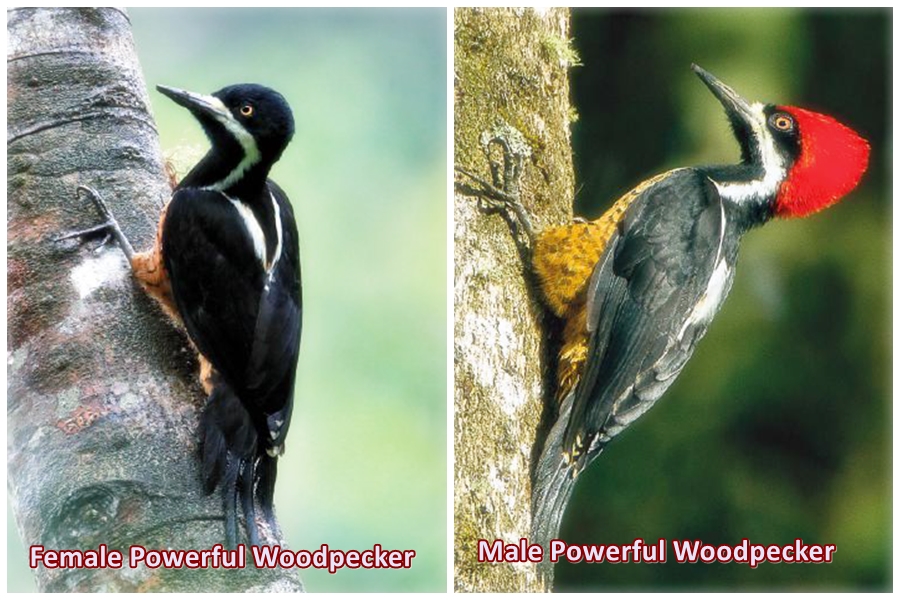-
Powerful Woodpecker (Campephilus pollens) face is mostly black crossed by a wide white stripe which runs from the bill and lores, over the cheek to the rear neck-sides, and then onto the scapulars and mantle, forming a V-shape on the back.
-
The Upperparts and tail are also black along with a white or buff rump obvious in flight. Throat and chest black. Ochre breast and belly with rows of black bars and chevrons. Wings black with white tips on primaries and spots or bars on secondaries. The bill is black and Iris pink or cream, while the legs are grayish.
-
Sexes are different: The male woodpecker has red nape, crown, and coned crest. However, the female bird lacks red on the head. The young woodpecker is like respective adults, but the male has less red on the head; both overall chocolate, greyer below with broader barring, more barred on the back, and with dark iris.
-
Powerful Woodpecker vocalizations have a limited range of simple calls. Normally, consists of single or repeated chooo or tjooo, more nasal keee-aah or kyaaah and falling, squeaky-toy-like pee-your, pee-yaw, or peeeseeew. Loud udd-daaa-da-da-da. Sometimes mocking and laughing, rapid kikikikikikaw, often made in flight, falling kikikiki-keh-kehkehkeh and kek-kek-kek-kek-kek. Single notes can develop into rattling, chattering, or laughing depending upon mood and situation.
-
The drumming calls of Powerful Woodpecker is a rapid double rap, but also often three, sometimes four to five strikes, almost forming a proper drum roll.
-
This woodpecker is nowhere common. Although inadequately known; the overall population size is unidentified, but considered stable. The powerful Woodpecker is rare and threatened by deforestation in Venezuela.
-
The habitats of Powerful Woodpecker are mature and secondary mountain rainforest and cloud-forest. Range South America. It is confined to high forests in N Andes, on either side of the Equator. It is usually found in more than 850m, up to 3500 meters.
-
There are two races: pollens (Andes in N Colombia, W Venezuela, and Ecuador) and peruvianus (Andes in N Peru), which are cinnamon or buff on the lower back and rump and narrowly barred buff on upper tail-coverts.
-
The similar species are Pale lower back and rump separates it from Lineated and Crimson-crested Woodpeckers; black and white neck and scapular lines separate it from Crimson-bellied, though ranges hardly coincide.
-
The food and foraging habitats are presumably large insects and their larvae, but precise information lacking. Usually forages in pairs on trunks and boughs inside forests from mid to lower levels.
Related Reading – The Striking Scarlet-backed Woodpecker
-

Male and Female Powerful Woodpecker